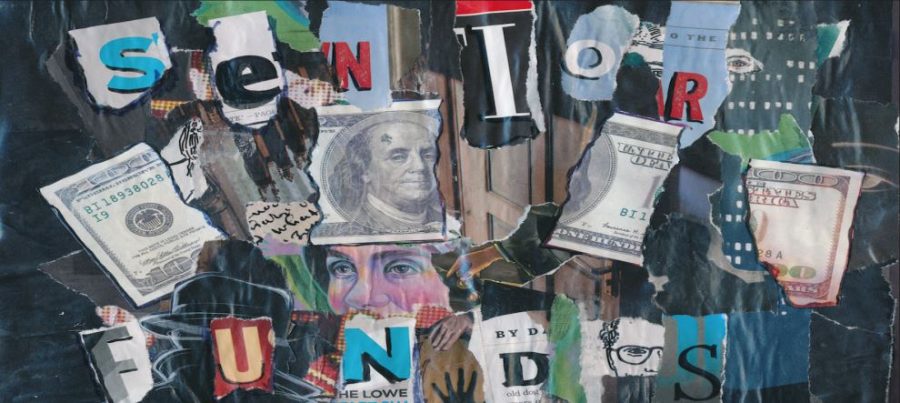Finding the funnel for senior funds
Our editor-in-chief goes down the rabbit hole: where does your senior ASB money go?
November 28, 2016
“There’s money that’s labeled for ‘senior activities’ [on the senior ASB package], and we don’t know where it’s going,” senior class treasurer Christopher Bried said.
Bried mentioned that the senior ASB package costs an additional $55. Out of the $55, $35 is labeled for nondescript “senior activities.” He questioned whether the extra money really goes back to seniors.
The ASB package that many students purchase during registration is priced at $185 this year, a discount from the original value of $225. According to the Wildcat Days Donation Form, it includes a “yearbook ($115), [ASB] shirt ($20), free admission to … athletic events and discounts on ASB dances and activities ($90 approx. value).” The senior ASB package, specially labeled and costing students a hefty $230, has all the same benefits with an extra graduation breakfast, worth $15 in value, and “discounts on senior activities ($35 approx. value)” tied into the bundle.
While $15 is explicitly labeled and set aside for the breakfast, the meaning of “senior activities,” which the $35 allegedly supports, remained a mystery.
“Officers were never informed [about this money],” Bried said.
Thirty-five dollars may not seem like much, but when bookkeeping records attest that 426 seniors bought an ASB package at registration, exactly $14,910 of extra money would have been collected from senior students and parents. The vague labeling of “senior activities” has caused confusion for the class officers on the whereabouts of the money.
When first approached, Thomas questioned what “senior activities” entailed. She suggested that the senior picnic or senior tailgate might be funded by the extra ASB package money, but Bried refuted this prediction.
“All events, such as the senior picnic, tailgate, spiritwear etc., are planned by senior officers, except for Grad Night. The PTA plans that,” Bried said.
All class officers extract the funds required for activities from the class’ bank account. Bried noted that all of the planned senior events use class money and are budgeted for.
In that case, it seems reasonable that the officers assumed some portion of money from the ASB package will enter the class of 2017’s funds, to offset the cost of events such as the tailgate and the picnic.
However, the aforementioned “senior activities” funds are not, according to Thomas, for the class’s events.
“The ASB package is a school fundraiser, not a class fundraiser,” she explained.
Administration analyzes the cost of general school expenditures such as technology and athletics, and organizes the pricing of the packages based on donation needs. Senior packages are more costly in order to help offset graduation costs and the senior breakfast. Therefore, the class officers are not entitled to the funds from the ASB package, hosting fundraisers for this reason.
Thomas also noted that the price of the ASB package in general is to “offset the cost of getting in [sports games] for free,” but the extra $35 from the seniors most likely serves as a buffer for graduation funds, so “[administration] doesn’t have to take from [senior class funds] for graduation.”
Principal Kravitz reported that the principal works with Thomas to organize the cost of the ASB packages. As the assistant principal during the time that the donation form was created, he did not have the jurisdiction to set the donation costs, or have knowledge of how the money would be spent. This authority would have been in the hands of former principal Daniel Hillman, who did not respond to a request for an interview.
Bowen could not confirm where the ASB money was allocated, since Leadership is also not consulted about ASB package pricing. He assumed that the funds supplement the bare minimum that the district provides Dougherty for the cost of the graduation event, which is $8,225, or offsets the cost of the Disneyland trip for students who request financial aid.
ASB treasurer Supriya Ravishankar admitted that she was not informed of the extra cost from the package.
“I only approve the expenditures that Mrs. Thomas gives me; I don’t manage them,” she said.
She, like Bowen, inferred that the costs would help with graduation and Disneyland.
Their conjectures were partially correct. After several interviews, Thomas gave me a thorough breakdown of where the money was headed, just before press time. According to her email to Hillman, the yearbook costs $90; the senior breakfast costs $15; $12 goes to athletics in return for the ASB benefit of going to home games for free; $50 goes to technology donations; $13 goes to the cost of running Dougherty’s webstore; $10 goes to graduation; $10 goes to the ASB t-shirt and $30 is returned to the general ASB fund, which is spent on student activities, such as guest speakers.
Thomas also emphasized in the email that the ASB package is “a school fundraiser, not a class fundraiser … admin looks at the cost of the items and indirect costs of activities.”
Although the costs in the email did amount to $230, there were slight discrepancies between the exact pricing for each item in the email and those displayed on the Donation Form. The original e-mail with the cost breakdown listed the yearbook as only $90, it was listed as $115 on the form; the ASB t-shirt was $10, whereas it was stated as a “class t-shirt” that cost $20. These minor differences merely suggest that the form may be outdated.
Regardless of what the money funds, Thomas assured that the money “all goes straight back to students, whether it’s for the grad fund, ASB [funds], or athletics.”
Anything that’s left directly rolls into the general ASB funds for the entire student body, although she pointed out that “there’s not very much [money] that carries over” each year.
Thus, it was settled. The extra costs of the senior ASB package are being spent on what they are intended to be spent on: seniors. My investigation came to a close, but not until after revealing that the vague and erroneous labeling of “discounts on other senior activities” was the main issue that upset seniors and was clouded with confusion.
“There should be more transparency as to where [the money] is being spent,” Bried concluded.
Seniors who were not in Leadership and had no knowledge about the school’s funds at all were even more concerned about being left in the dark.
Senior Riza Ali also commented about the labeling of the donation form, and stated that he would prefer to know more about how the money was being spent.
“I have no idea what ‘senior activities’ encompasses,” he said. “It could mean anything.”
Nickolas Nguyen was misled to believe that the money was intended for senior-exclusive activities such as a field day or the picnic.
“I would assume that I’m going to events that are sponsored by my money,” he added. “[The labeling] should be more specific.”
Now that the direction of the senior ASB package funds are clear, Kravitz assured that if there were any questions left, he would gladly address them.
“We always look at our practices,” he said. “If we can clarify with the senior officers or with Leadership, since there seems to be some confusion, we’d be happy to.”
While helpful administrative staff, such as Thomas and Kravitz, provided the exact information that located the funds, the initial lack of knowledge of the funds’ existence, the misunderstanding between the senior class and the administration, the discrepancy between the funds listed on the donation form and the actual expenditures listed and the length of time it took to extract supposedly public information regarding school expenditures were concerning.
Administration seeks to resolve the lack of transparency by providing more information on how money is spent and clearing up the miscommunication that resulted from vague labeling.
“It might be time to re-look at the money,” Thomas said. “And it might be time to get students involved [in the process].”


